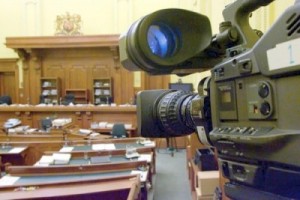Big Step Towards Use of Cameras in the Courtroom
 The use of cameras in the courtroom has always been a hotly debated topic. It took a long while before still photography was allowed in the courtroom; now all fifty states in many circumstances allow video recording during court sessions. On the other hand, federal courts are still very restrictive when it comes to video recordings of hearings. Recently, a new experimental program is pushing the limits of what is acceptable in terms of digital camera recordings in U.S. courtrooms.
The use of cameras in the courtroom has always been a hotly debated topic. It took a long while before still photography was allowed in the courtroom; now all fifty states in many circumstances allow video recording during court sessions. On the other hand, federal courts are still very restrictive when it comes to video recordings of hearings. Recently, a new experimental program is pushing the limits of what is acceptable in terms of digital camera recordings in U.S. courtrooms.
The Administrative Office of the U.S. Courts is pushing a pilot program involving 14 different courtrooms across the country. The programs will allow the videotaping of selected trials in civil courtrooms. The recordings are to be digitally uploaded to a government website and made available for the public to view. Accordingly, many lawyers and judges are enthusiastic about cameras in the courtroom and what this could mean for the judicial branch as a whole.
Advocates of the program usually cite “education” as one of the main benefits of the use of camera recordings during trial. That is, allowing the public to view recordings of courtroom sessions would serve to educate the average citizen on how courtroom proceedings are actually run. I agree with this logic, since the average citizen gets their idea of court hearings either from the O.J. Simpson trial or from Lindsay Lohan’s legal woes. Suffice to say, celebrity trials don’t really provide the public with a well-rounded or even accurate picture of trial proceedings. So, the idea of cameras in the courtroom can have the effect of curbing some of the sensationalism associated with celebrity trials.
Another argument in support of the pilot program is that the recordings will help with judicial accountability and transparency. Unlike the other branches of government, the judiciary has been largely resistant to video recordings of sessions. This is especially true of the federal court system, which has been video camera-shy for ages now. It could be that the lack of cameras in the courtroom allows lawyers to get away with some questionable behind-the-scenes conduct, and contributes to judges legislating from the bench. So having the hearings video taped would supposedly expose/reduce some of this.
On the other hand, one of the main arguments against recording court sessions is that the presence of cameras might change the courtroom dynamic. For example, a lawyer might be hesitant to argue a certain legal theory because they become self-conscious about how the public might perceive them. Jurors and witnesses might also be intimidated knowing that they would be on camera. Or, on the other end of the spectrum, there is concern that a lawyer (and even a judge) might become overly dramatic if they know that they’re in the spotlight. Given some of the courtroom dramatics involved in past celebrity lawsuits, there is some basis to this argument.
In my opinion, I like the idea of this new program to record and upload court hearings for public viewing. As Chief Judge Kozinski of the Ninth Circuit put it, it’s time for courts to get with the times and take advantage of the different technologies available to us. Critics argue that the written transcripts and courtroom sketches are enough for the public to work with. But I think it would be a sorely missed opportunity not to be able to watch trials through a full video presentation (though I do agree that camera footage needs to be monitored so that courts don’t reinforce the circus stereotype associated with media trials).
Many of the concerns listed here are minimized by several elements inherent in the pilot program. First, the cameras are not media cameras, but will be operated and regulated by court staff. And the equipment will be unobtrusive (like the “eyeball” cameras you often see implanted in the ceilings of some stores- not like the bulky cameras we have fashionably pictured here). Courts will also limit the recordings to cases that don’t involve sensitive issues like child abuse, sexual assault, or trade secrets. Lastly, to help with privacy concerns, all participants in the trial should consent to the videotaping before it occurs.
And one aspect that isn’t mentioned in the midst of this debate is the prospective advantage for law students. I remember during law school, we watched some very limited footage that was supposed to help us students with our litigation skills. But it would have been nice to be able to independently browse different trials to see how lawyers actually argue in different types of case settings. Also, having a database of actual trial footage can help those who may be contemplating a law career make a choice of whether to invest in law school or not.
On a final note, I’d like to leave you with bit of legalese that I found very amusing. The legal phrase “in camera” comes from the Latin word meaning “chambers”. It refers to a trial that’s conducted in private without the public watching and without coverage by the press. How ironic! If this new pilot program catches on nationwide, the definition of “in camera” might well be turned on its head.
What our clients think
At LegalMatch, we value our client’s opinion and make it a point to address their concerns. You can refer to our reviews page if you want to know what our clients have to say about us.

Comments